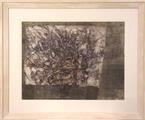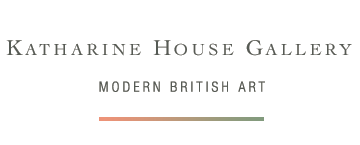Roy Turner Durrant (1925 - 1998)
Please click on the image for details and price.

Inscape: Groton Wood. 1974
Biography
Roy Turner Durrant, Suffolk-born and East-Anglian based, was in his own way an artist of a typically English sort, and very much of his time. Not all serious and talented artists necessarily achieve the wider reputation they deserve, and Durrant's has been a sleeping reputation. He studied at Camberwell in the years immediately after WW2 and emerged as one of that second generation of Neo-Romantic painters, post Sutherland and Piper, with artists such as Craxton, Vaughan, Pasmore, Minton and Alan Reynolds as his contemporaries. Throughout the later 1950s, rather like Reynolds in particular, and perhaps as Pasmore had a year or two earlier, Durrant's work would move from an increasingly stylised representation of the landscape towards abstraction. With the later, simpler abstract works of the 1970s, there remains always a strong feel for surface and texture, closer in spirit perhaps to the work of painters such as William Scott, Patrick Heron and Henry Mundy.It is a measure of the quality of Durrant's work that even with this carefully curated selection of his work, from the 1950s to the 1980s, the references and contexts that come immediately and naturally to mind are with the leading painters of the time. He was nevertheless entirely his own man, perfectly content to go his own way, in no sense a follower but rather an artist among his peers.
Exhibitions:
1948 Guildhall, Lavenham;
1949 Cromwell Gallery, London;
1950 Beaux Art Gallery, London; Kensington Art Gallery, London & Playhouse Theatre, Kidderminster;
1952 The Coffee House, Trafalgar Square, London;
1953 Parsons Gallery, Grosvenor Street, London & A.I.A. Gallery, London;
1954 Rowland Browse and Delbanco & County Cinema, Sudbury;
1957 New Vision Gallery & A.I.A. Gallery, London;
1958 Foyer Gallery, Everyman Cinema, Hampstead;
1959 Grabowski Gallery, London;
1960 New Gallery, Ipswich, Phoenix Gallery Lavenham & New Vision Centre Gallery, London;
1961 Gainsborough's House, Sudbury;
1969 A.I.A. Gallery, London & University of Cambridge;
1972 St John's Wood Public Library & Old Fire Engine House, Ely;
1973 The Manor Gallery, Royston & Loggia Gallery, London;
1974 Old Fire Engine House, Ely, Halesworth Gallery, Suffolk & Cambridge Art and Design Gallery;
1975 Loggia Gallery, London;
1976 Deben Gallery, Woodbridge & Caius College, Cambridge;
1977 University of Cambridge;
1980 Old Fire Engine House, Ely;
1981 Loggia Gallery, London;
1984 Loggia Gallery, London;
1988 Gallery of British Art, Lausanne;
1991 The Belgrave Gallery.
In 2008 the first substantial exhibition of Durrant's work in over twenty years was held at The Fine Art Society in association with Katharine House Gallery.


